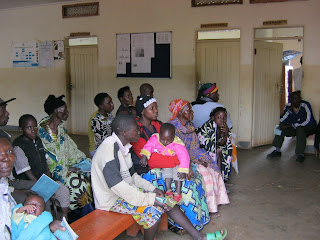












Medical Teams International (MTI) (http://www.medicalteams.org) called for volunteers to serve in their clinic at the Nakivale Refugee Camp in Uganda near the borders of Congo and Rwanda when they had their grant from the Bureau of Population, Refugees, and Migration (BPRM) from the US State Department renewed last year. MTI has been here serving the 27,000 plus refugees since December of 2008 in collaboration with a number of organizations including the Ugandan government and UNHCR. They have now set up a permanent clinic location which provides primary healthcare services to the people living in the Ngarama district. Their goal for the volunteer teams and the national staff is to reduce morbidity and mortality of the Congolese refugees living in the Nakivale Refugee Camp. Besides Congolese they serve refugees from other countries such as Rwanda, Burundi, Sudan, Somalia, Ethiopia and Eritrea.
I was delighted to volunteer with MTI. I volunteered with them in their Haiti cholera outbreak effort last December and found my time there very rewarding.
I was in Uganda in 2007 volunteering with the Infectious Disease Institute in Kampala under the Infectious Disease Society of America teaching a HIV/AIDS course at the Makarere University. I am quite familiar with the country having traveled to Bwinde Impenetrable Forest to trek the gorillas, visited some national parks and even did a 9-day hike up the tallest mountain, Mt. Margarita of the Rwenzori Mountain Range or Mountains of the Moon.
We arrived in Kampala on June 24. Kampala has not changed much, being still busy and has its shares of slums. Pavements are potholed and trucks parked neatly in a row on the pavements forcing pedestrians to walk on the hazardous roads where Boda Boda (Motor bike Taxis)and Mtatu (VW van bus) seem to ignore their existence. My volunteer partner and I walked through the wards of Mulago Hospital which still has its patients spilling out in the hallways and on the floors.
The next day we drove westwards for about 5 hours over some bumpy roads to Mbarara, a small bustling town, a little dusty and to our home; a nice guest house of 3 bedrooms, 2 baths, a living/dinning room and a kitchen. We have Opio and Sheila, our housekeeper and cook to take care of us. The blessing is that the house is situated about 20 to 30 minutes by walking from the center of town, more like in a quiet village.
On Sunday Opio and I walked to church. Wouldn't you know it? It is called All Saints' Church just like my church at home. The differences are obvious: I thought my ear drums would burst with the rousing singing over microphones. There must be about two thousand people there and spare chairs continued to be put out for people to sit. The church was built 15 to 20 years ago and already it has outgrown its capacity. To its left a new foundation has been built for a new church and they are busy fund raising for it. To its right is the tiny tin shed that was the first church which is now used as the Sunday school. This church is sure growing.
On Monday, we traveled over red-earth bumpy roads for an hour to visit the Nakivale Refugee Camp sites. There are several camps for different groups. We also visited the center where the refugees are being processed. These days there are between 5 to 10 new refugees a day, much reduced from years ago. The refugees are given food, tent sheets and a plot of land to grow crops. The camps now look more like semi-permanent settlement areas with the refugees building houses made of sticks, mud and thatched or plastic sheet roofs. Around the houses are corns and various kinds of vegetables. There seem to be numerous children running around the compounds. UNHCR logos are everywhere. We were taken to two other clinics besides ours, all of which seemed to be crowded with waiting patients, mostly women and children.
A heavy downpour greeted our first day in the clinic, there were a few patients sitting in the waiting room. We soon saw a string of children with high fevers and almost all of them had malaria. We made our morning rounds in the make-shift tent area with UNHCR stamped on the plastic sheeting. Almost all the patients who stayed overnight were babies with the exception of a grown man. And all the children were being treated for malaria. Overnight they had all recovered sufficiently to be sent home. The clinic is quite well equipped with 3 to 4 examination rooms, a prenatal/maternity section, a laboratory, a pharmacy dispensing area and a stock room for medications and several waiting areas.
Throughout the day we continued to see a stream of patients who were mainly quite ill: patients with fever, cough, abdominal pain, diarrhea, vomiting. Many had the diagnosis of malaria. Yes there are many mosquitoes here and malaria reigns supreme.